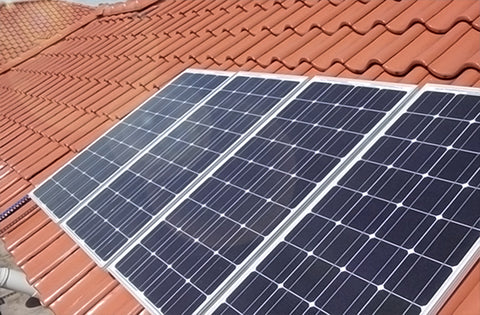A hybrid wind-solar energy system consists of the following components:
- Solar panels
- Wind turbine – see our guide to the best wind turbines
- Charge controller
- Battery bank
- Inverter
- Power distribution panel
These hybrid systems operate off-grid, so you can’t rely on an electricity distribution system in an emergency.
A bank of batteries provides backup power for those wind-still, overcast days, or you can incorporate an existing emergency generator into the system.
This adaptation will make the system more complex, but a good-quality charge controller can operate all three components automatically.
Including the generator in the system also means we can get by on a smaller battery bank.
You can also convert a pre-existing solar system into a hybrid setup by adding a wind turbine and replacing your solar inverter with a hybrid model.
Can You Erect A Wind Turbine In A Residential Area?
Before you set your heart on a hybrid wind-solar energy kit, like this one, however, you should familiarize yourself with the laws governing the legality of wind turbines in residential areas.
Zoning laws may prohibit you from installing a wind turbine in your area, while building-code authorities often limit the height of structures in a residential zone to 35ft.
You would also need to comply with federal legislation restricting noise pollution in residential areas and the US Fish and Wildlife Service’s wind turbine guidelines on protecting migrating and endangered birds.
Pros and Cons of Hybrid Wind-Solar Energy Systems
The advantages of a hybrid wind-solar energy system include:
With a wind turbine, solar panels, and a bank of batteries, you’ll be one of the few people in the world to have power 24/7, 365 days a year. You’ll have the sun producing energy during the day, the wind generating it at night, and the batteries storing it for up to five days.
#2 Reliable Energy Provision
With a hybrid energy system, you’re hedging your bets. If the sun isn’t shining, you’ve got the wind to fall back on. If that dies, you can turn to your backup generator or battery bank to keep you going. By taking this hybrid approach, you gain an energy system that’s considerably more reliable than the US electric grid.
#3 Device-Friendly Energy Supply
The charge controller within a hybrid solar-wind energy system provides a properly managed and consistent energy flow which isn’t always possible with traditional energy sources.
#4 Minimal Life-Cycle and Running Costs
Renewable energy systems are easy and cheap to maintain. Hybrid energy systems are even more cost-effective as the pressure is shared between the different energy-generating systems.
Every system has its disadvantages, and a hybrid solar-wind energy system is no exception.
The negatives of installing a hybrid system include:
#1 Expensive Installation
Although a hybrid energy system will save you money on your electricity bills, the upfront cost is pretty steep. The best hybrid wind-solar systems can cost anywhere between $1800 and $11,000, depending on your energy requirements. In many instances, these prices don’t include batteries or installation.
You can reduce the initial outlay with a US Residential Renewable Energy Tax Credit and offset the remainder with the money you save on your monthly energy bills.
#2 Limited Battery Life
In a hybrid energy system, the batteries are outside and exposed to the elements, and the constant exposure to sun, rain, and wind will inevitably reduce their average life expectancy.
#3 Complex System
With so many different components and a highly sophisticated charge controller, maintaining and monitoring a hybrid solar-wind system requires some knowledge and technical know-how.
Getting Started With a Hybrid Solar-Wind Energy System
Before investing in a hybrid solar-wind energy system, you need a clear idea of your energy consumption.
An energy auditor can do this for you, or you can do it yourself using the resources available online. Energy calculators like this one can help you calculate how much energy you use depending on the appliances you have in your home.
Performing these calculations will also help you identify any areas where you could cut back on your monthly energy consumption, thereby reducing the size – and cost – of the hybrid energy system required.
The next step is figuring out how much wind and sun your home receives so you can establish whether or not it’s sufficient for your needs.
Establishing how much wind power is available is more challenging. Airports regularly produce wind maps and reports detailing the average daily wind speed in the local area.
A more accurate way of measuring wind power is to fit an anemometer to the top of a mast that’s the same height as your prospective turbine.
Once you know how much energy you use and how much you can potentially generate, you’ll have a much clearer idea of which hybrid wind-solar system is best for you.
To learn more about photovoltaic power generation, please follow SOLARPARTS official website:
Homepage: www.isolarparts.com
Email address: Philip@isolarparts.com






